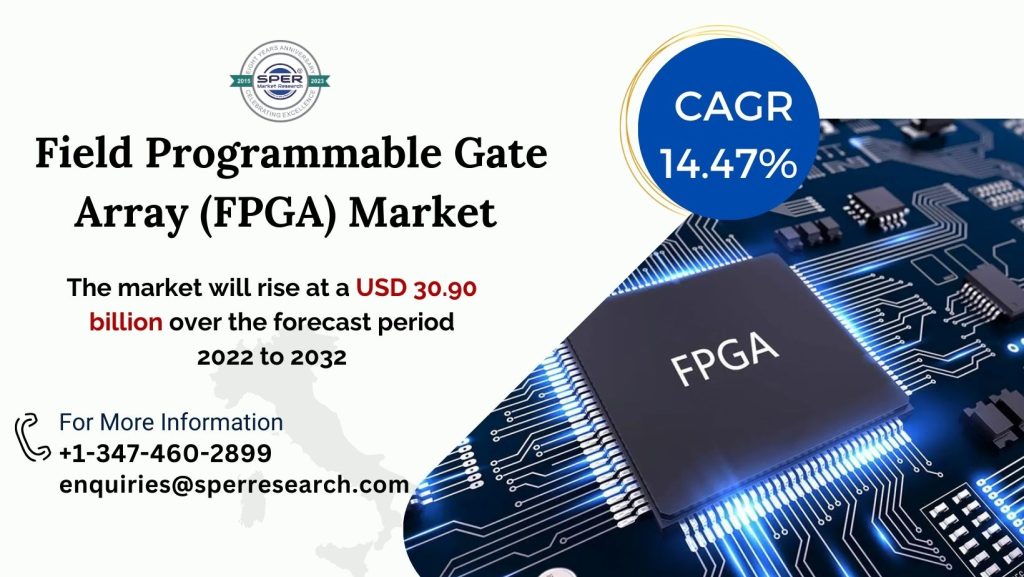A matrix of customizable logic blocks (CLBs) coupled via programmable interconnects is the foundation of Field Programmable Gate Arrays (FPGAs), which are semiconductor devices. FPGAs are reprogrammable to meet specific functional or application needs once they are manufactured. Application Specific Integrated Circuits (ASICs), which are made to order for particular design tasks, are differentiated from FPGAs by this property. Despite the availability of one-time programmable (OTP) FPGAs, SRAM-based FPGAs are more common and can be programmed to change with the design. FPGAs are a perfect fit for a wide range of markets because of their programmable nature. For markets and applications like aerospace and defense, AMD, the industry leader, offers complete solutions that include FPGA devices, cutting-edge software, and configurable, ready-to-use IP cores. These solutions include radiation-tolerant FPGAs as well as intellectual property for image processing, waveform generation, and partial reconfiguration for SDRs.
According to SPER Market Research, ‘Field Programmable Gate Array (FPGA) Market Size- By Application, By Technology- Regional Outlook, Competitive Strategies and Segment Forecast to 2032′ states that the Global Field programmable gate array (FPGA) market is estimated to reach USD 30.90 billion by 2032 with a CAGR of 14.47%.
Applications involving complex motor control and vision processing have changed as a result of the broad use of artificial intelligence (AI) and the Internet of Things (IoT) across a variety of industries. Due to the hard-deterministic nature of Field-Programmable Gate Arrays (FPGAs) and the fact that these activities require sophisticated computational skills and deterministic, real-time system behavior, FPGA use has exploded worldwide. Innovation in business models and major technological developments in the FPGA domain have been fueled by the confluence of AI and IoT. Smart power grids, intelligent buildings, networked cars, and urban infrastructure are just a few of the advances that are made possible by FPGAs.
For FPGA designers as well as consumers, the absence of industry standardization presents a number of obstacles. The difficulty and duration of design projects grow when designers have to deal with the complexities of various FPGA architectures and toolchains. Furthermore, the absence of standards restricts the portability of FPGA designs, which makes it challenging to reuse and repurpose designs on various FPGA platforms.This absence of standards is further exacerbated by the quick speed at which FPGA technology is developing. Designers must modify their tools and design processes in response to changing architectures and capabilities offered by FPGA vendors. Since designers could be hesitant to engage in tool updates and training, this constant change could impede the adoption of new FPGA technology.
Request For Free Sample Report @ https://www.sperresearch.com/report-store/fpga-market.aspx?sample=1
The globe was plunged into a catastrophe when the Corona virus, believed to have started in China, swiftly spread throughout the world. All parties involved in the value chain, including companies and consumers globally, are experiencing significant worry and financial suffering as a result of the COVID-19 epidemic. The sickness completely impacted industrial facilities and supply chains worldwide, especially in the case of raw materials involving industries like electronics, automotive, and many more. Governmental organizations ordered a complete lockdown to stop the disease’s spread. Consequently, the semiconductor industry’s embedded FPGA market experienced production setbacks and a disruption in the supply chain, leading to market slowdown.
FPGA Market Key Players:
The growing demand for mobile devices and high-speed internet services, especially from consumers in China and India, is propelling the expansion of the Asia Pacific market. Some of the key players are – Achronix, Atmel, E2V, Intel Corporation, Lattice Corporation, Lattice Semiconductor Corporation, Motorchip Technologies, Microsemi Corporation.
Global Field Programmable Gate Array (FPGA) Market Segmentation:
By Application:
- Data Processing
- Consumer Electronics
- Industrial
- Military & Aerospace
- Automotive
- TelecomOthers
By Technology:
- EEPROM
- Antifuse
- SRAM
- Flash
- Others
For More Information about this Report: –
Field Programmable Gate Array (FPGA) Market Outlook
Related Reports:
Follow Us –
LinkedIn | Instagram | Facebook | Twitter
Contact Us:
Sara Lopes, Business Consultant – USA
SPER Market Research
+1-347-460-2899



